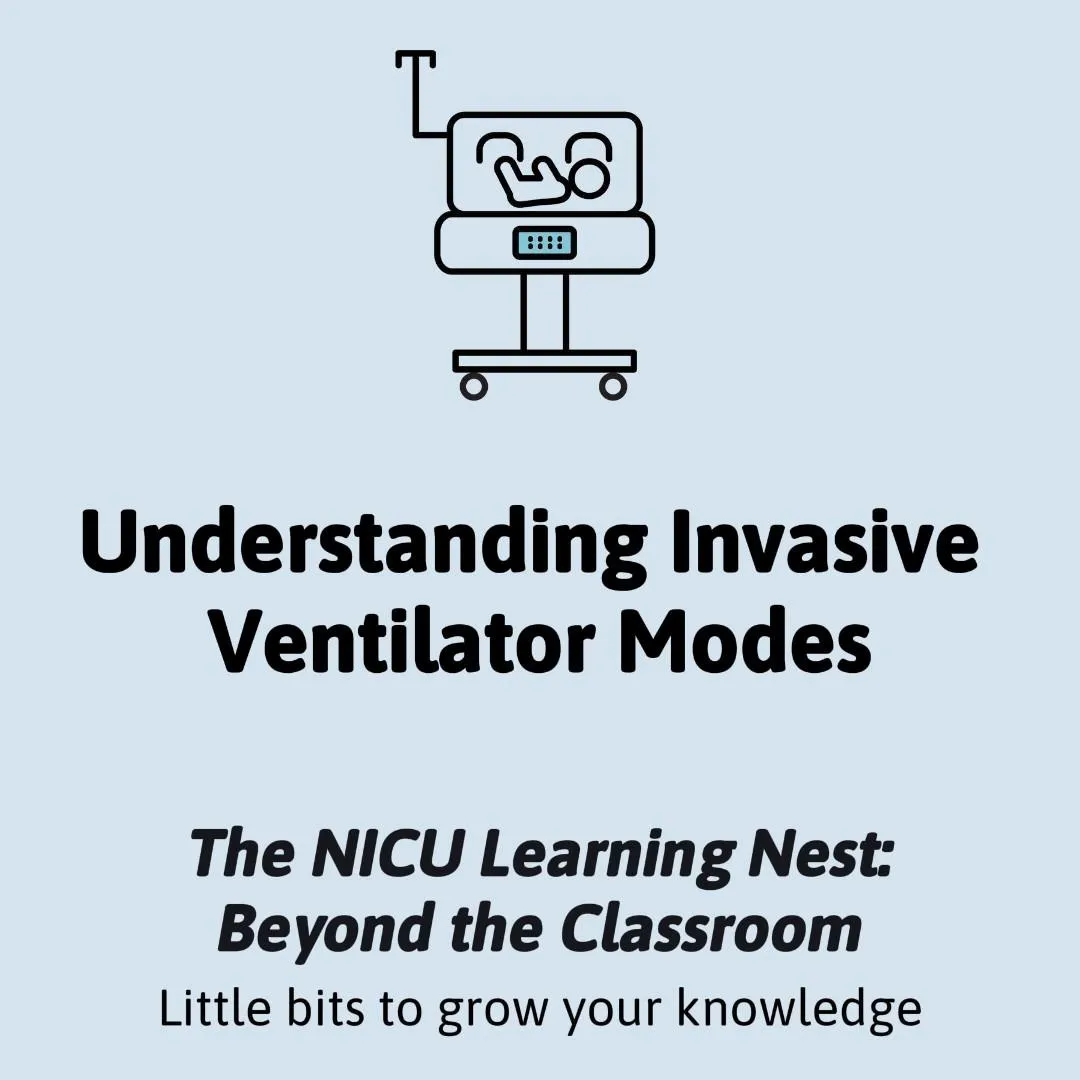
Top Ventilator Modes
Understanding Invasive Ventilator Modes in the NICU: Matching the Mode to the Baby
Mechanical ventilation remains one of the most powerful—and delicate—tools in neonatal care. Each ventilator mode tells a story about how the baby’s lungs are functioning and how much support they need. For NICU nurses, understanding what we’re setting, what we’re seeing, and why the team selects a particular mode helps us interpret trends, anticipate changes, and communicate more confidently at the bedside.
It’s also important to remember that ventilator modes aren’t always used in a perfect sequence. Care isn’t linear; we don’t simply “move up and down the ladder.” Instead, we choose the mode that best fits the baby’s physiology that day—whether they need gentle support or full assistance. Knowing how each mode works allows nurses to “read” the baby’s respiratory story with insight and intention.
1. PC-PSV (Pressure Control – Pressure Support Ventilation)
This mode provides the least amount of invasive support. The baby determines their own rate and inspiratory time while the ventilator adds pressure support to overcome the resistance of the endotracheal tube. It’s often used as the final step before extubation, helping assess the baby’s readiness to breathe independently. Nurses monitor comfort, effort, and endurance—making sure those measured values stay stable as support decreases.
2. SIMV-PC (Synchronized Intermittent Mandatory Ventilation – Pressure Control)
SIMV-PC delivers a set number of pressure-controlled breaths while allowing spontaneous breathing between them. Synchronization helps the ventilator work with the baby, reducing asynchrony and fatigue. This mode is common during recovery or weaning when the baby is taking more of their own breaths but still needs consistent pressures to maintain alveolar stability.
3. SIMV-VC (Synchronized Intermittent Mandatory Ventilation – Volume Control)
In this mode, each mandatory breath delivers a consistent volume while spontaneous breaths vary depending on the baby’s effort. It allows for more precise CO₂ control while preserving some independence. Nurses often see this used when a baby is transitioning off full support but still needs stable ventilation while compliance and drive fluctuate.
4. AC-PC (Assist Control – Pressure Control)
AC-PC ensures every breath—spontaneous or mandatory—receives the same pressure. This provides reliable alveolar recruitment and stable mean airway pressures, particularly helpful when the infant is too weak or sedated to generate strong effort. It’s frequently used early in the disease process, immediately post-resuscitation, or when consistent pressure delivery helps maintain lung inflation despite air leaks.
5. AC-VC (Assist Control – Volume Control)
Each breath delivers a set tidal volume, and the ventilator adjusts pressure automatically to achieve it. AC-VC provides tight control of ventilation and CO₂ removal, making it a preferred choice for infants with more stable lung compliance or those recovering from RDS. It’s often an initial mode of ventilation when precise control and predictability are priorities.
6. NAVA (Neurally Adjusted Ventilatory Assist)
NAVA takes synchronization to the next level. Using an Edi catheter that senses electrical activity from the diaphragm, the ventilator provides assistance that matches each breath’s timing and intensity. In simple terms—it listens to the baby’s brain signal for breathing and responds in real time. This can improve comfort, reduce asynchrony, and shorten ventilation duration, especially for preterm infants with irregular respiratory drive.
7. HFOV (High-Frequency Oscillatory Ventilation)
HFOV maintains constant lung inflation while delivering hundreds of tiny, rapid breaths per minute. It’s often used when conventional ventilation isn’t enough—such as in diffuse atelectasis, severe RDS, or oxygenation failure. Nursing focus shifts toward assessing chest wiggle, monitoring gases, and ensuring circuit integrity. HFOV represents a major escalation in support, but it’s a powerful tool for gentle lung recruitment.
8. HFJV (High-Frequency Jet Ventilation)
HFJV provides active inspiration through high-velocity jets of gas, followed by passive exhalation. This approach promotes CO₂ clearance with less volume trauma. It’s especially effective for air-leak syndromes like PIE or pneumothorax, or for babies needing high mean airway pressures. Unlike HFOV, visible chest movement may be minimal, so assessment relies on measured values and blood gases rather than wiggle alone.
Helping Families Understand What They See
For parents, ventilators can look—and sound—terrifying. A few calm explanations can change everything.
You might say:
“This ventilator is helping your baby breathe. Some modes give full support when lungs are very tired, and others give gentle help as your baby starts to do more on their own. The team adjusts it as your baby gets stronger.”
Clear language reassures families that ventilator changes are signs of personalized care, not necessarily decline.
Bringing It All Together
Understanding invasive ventilator modes goes far beyond memorizing acronyms. It’s about recognizing how each setting supports the baby’s unique journey toward stability. From PC-PSV to HFJV, every mode represents a thoughtful balance between support and independence.
When nurses understand what’s fixed, what’s variable, and what the measured values truly mean, we move from reacting to anticipating. We communicate more clearly, notice subtle trends sooner, and become even stronger advocates for the babies we care for.
If you’d like a deeper dive into ventilator interpretation, measured versus set values, and how to apply the BREATHE Framework at the bedside, explore the on-demand webinar “Connecting the Dots: Assessment, Blood Gases & Ventilation”—available through Lisa’s NICU Learning Nest.
